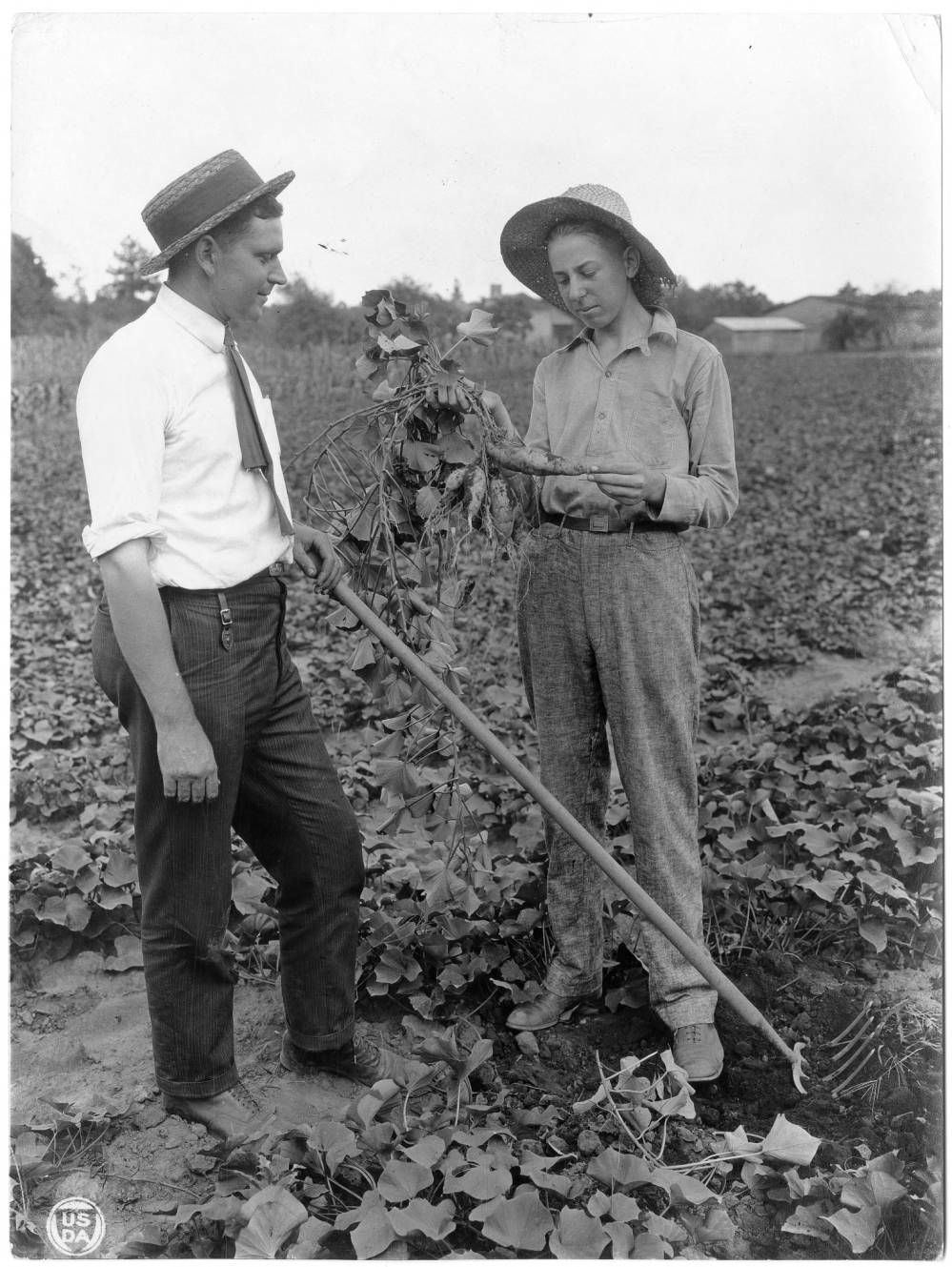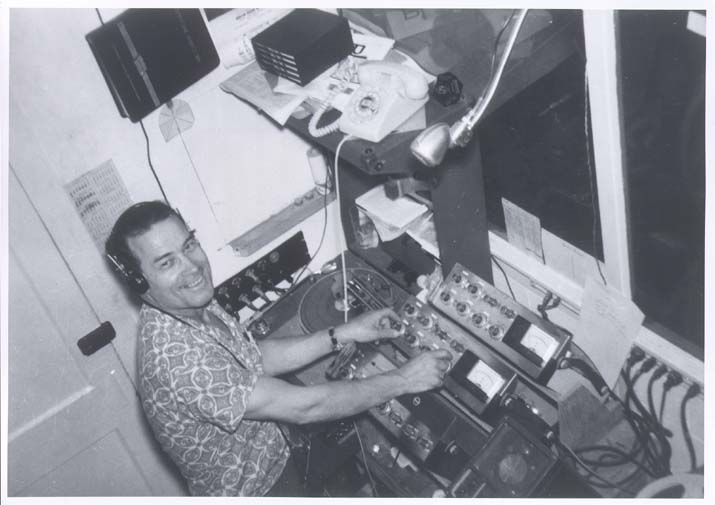 Getting super excited for the Masters of Cajun Accordion event coming up this weekend at The ArtsCenter in Carrboro. Tickets are available now. Jo-El Sonnier and Steve Riley are two of the finest button box players around. Be sure to come early to hear Professor Barry Jean-Ancelet present You can also pickup the Southern Folklife Collection’s newest release, a remastered reissue of Goldband records classic Swampland Jewels. More information below. Follow the SFC on Facebook and Instagram to get ready for the show and hear some deep cuts from Jo-El’s discography over the next couple days. We’ll see you on Sunday!
Getting super excited for the Masters of Cajun Accordion event coming up this weekend at The ArtsCenter in Carrboro. Tickets are available now. Jo-El Sonnier and Steve Riley are two of the finest button box players around. Be sure to come early to hear Professor Barry Jean-Ancelet present You can also pickup the Southern Folklife Collection’s newest release, a remastered reissue of Goldband records classic Swampland Jewels. More information below. Follow the SFC on Facebook and Instagram to get ready for the show and hear some deep cuts from Jo-El’s discography over the next couple days. We’ll see you on Sunday!
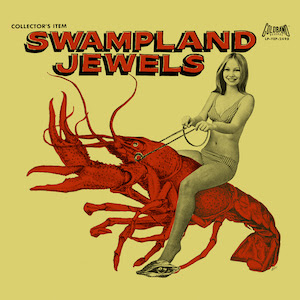
Concert is ticketed: $17.50 Public, $26.50 CD Bundle, $30.50 LP Bundle.
(CD/LP bundles include a copy of the record Swampland Jewels.)
Tickets available at artscenterlive.org or (919) 929-2787
Reception and lecture are free and open to the public.
5:30 p.m. Reception
6:00 p.m. Lecture: Professor Barry Jean Ancelet, University of Louisiana, Lafayette
7:30 p.m. Concert: Jo-El Sonnier with Steve Riley and the Mamou Playboys
Category: Goldband Collection
SFC Hits 20,000 Streaming Recordings!

With the more recent addition of video content and the increase in production in our audio studios since starting our Andrew W. Mellon Foundation grant in August 2015, there’s a lot to explore online. Since it might be overwhelming to know where to start, I thought I’d share my top 5 countdown of memorable moments from watching and listening over the last couple of months.
5. The time Dr. William R. Ferris panned across the Mississippi and framed the New Orleans skyline, from the vantage point of what is now the Crescent City Park in the Bywater (one of my favorite places in N.O!), while documenting his trip on the Delta Queen in 1987 (VT-20367/24).
Starts around the 33 minute mark

Delta Queen, 17-24 April 1987: tape 1 of 4
Dr. William R. Ferris Collection, 20367
Video8
4. Finding this disc in the stacks during a conservation survey and spending many weeks curious about its contents before finally having it digitized. I’d be very curious if anyone knows the whereabouts of this band. (FD-20245/836)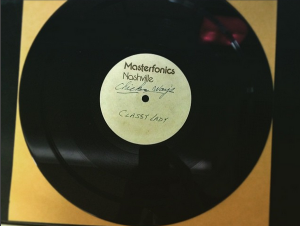
Chicken Way’s “Classy Lady ”
Goldband Recording Corporation Collection, 20245
Instantaneous disc
3. When James “Son” Thomas performed with George Thorogood and Ron Smith, and the video switcher employed some creative video effects (VT-20466/3)
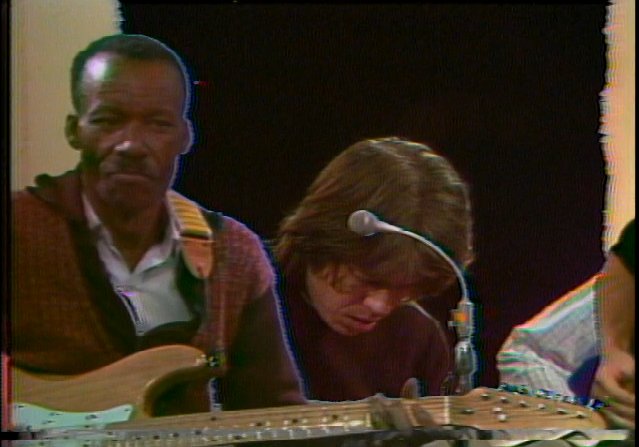 James “”Son Ford”” Thomas with George Thorogood and Ron Smith, 1978
James “”Son Ford”” Thomas with George Thorogood and Ron Smith, 1978
Robert D. Bethke Collection, 20466
U-Matic
2. This SFC department favorite featuring Hazel Dickens, Alice Gerrard, Mike Seeger, Tracey Schwartz and a beautiful sunny backdrop (VT-20006/2). Bonus music videos by unidentified bands at the end!
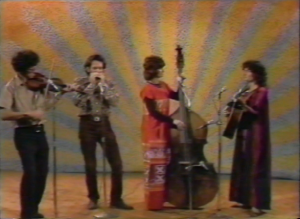
Woman Alive: Hazel Dickens and Alice Gerrard with Mike Seeger and Tracey Schwartz, November 1975
Alice Gerrard Collection, 20006
VHS dub from unknown format
LAST, BUT NOT LEAST….
1. When a nightmarish Barney joined a Mt. Airy dance contest (VT-20009/272). The beloved dinosaur from our imagination appears around 5:20 minute mark
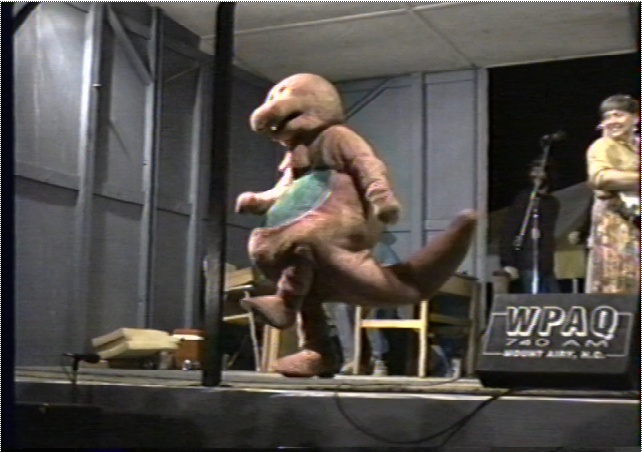
Mt Airy Fiddlers convention, dance contest Rufus Kasey, Molln part 2, 1997
Mike Seeger Collection, 20009
Video8
Happy Field Tripping!
A look inside Goldband
 A peek into Eddie Shuler’s Goldband complex–including recording studio, record store, and TV store–in Lake Charles, LA, from the now digitized Goldband photo albums. For more see the Goldband Recording Corportaion Collection (20245) finding aid. Above is Wild Bill Pitre of Wild Bill and the Blue Washboard Boys. Below, Eddie Shuler at the desk in his control room. And finally, Count Rockin’ Sidney below.
A peek into Eddie Shuler’s Goldband complex–including recording studio, record store, and TV store–in Lake Charles, LA, from the now digitized Goldband photo albums. For more see the Goldband Recording Corportaion Collection (20245) finding aid. Above is Wild Bill Pitre of Wild Bill and the Blue Washboard Boys. Below, Eddie Shuler at the desk in his control room. And finally, Count Rockin’ Sidney below.
These images were preserved as part of the Southern Folklife Collection digitization project, From the Piedmont to the Swamplands: Preserving Southern Traditional Music, funded by a grant from the National Endowment for the Humanities.
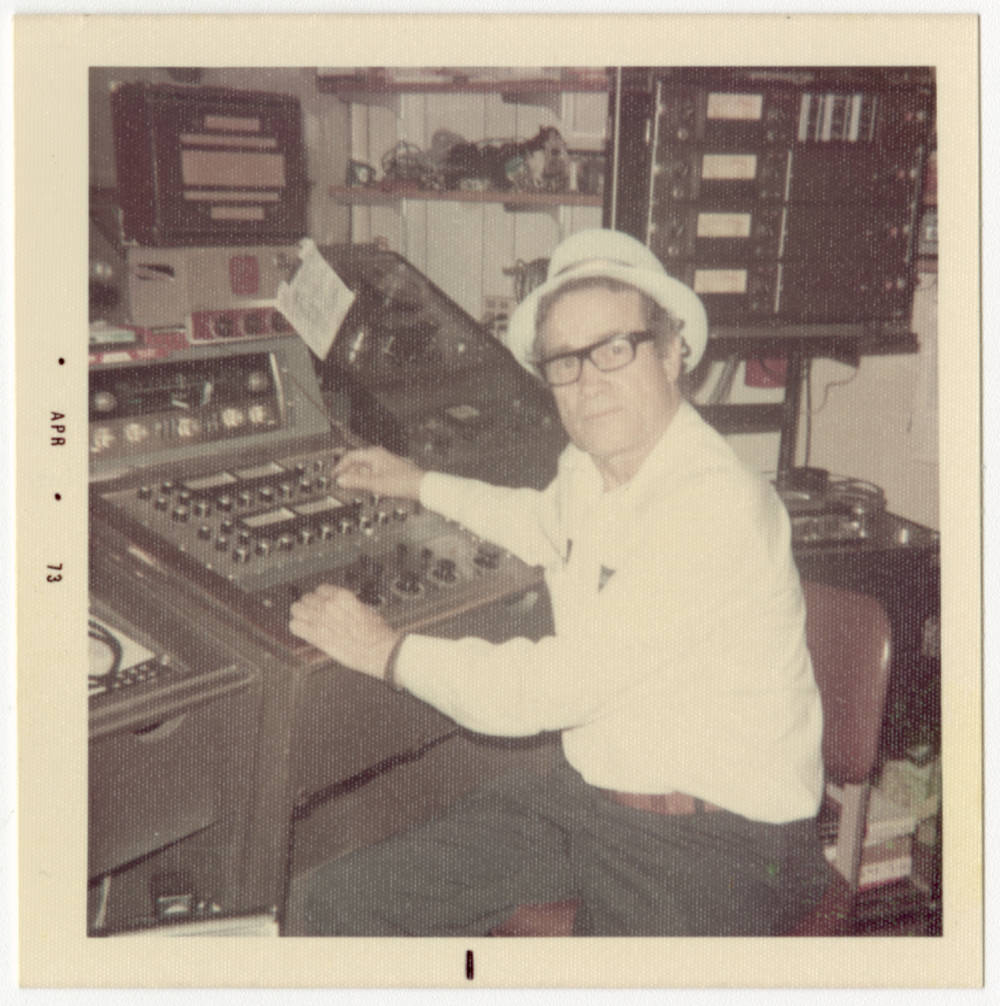

Goldband Records approved "Sweet Potato Mash"
Sweet potato patch in Cleveland County,
call no. P0072/0010, Commercial Museum Collection of North Carolina Photographs (P0072)
North Carolina Collection Photographic Archives.
Don’t forget your eat your sweet potatoes tomorrow. No matter whether you roast them, bake them, fry them, hasselback them, or cook them with marshmallows on top, the Southern Folklife Collection has your soundtrack covered thanks to a seasonally appropriate tape from the Goldband Recording Corporation Collection (20245) that came up in the Rivers Studio just this week.

William Parker Guidry, Jr., came up in Southwest Louisiana and Lake Charles, performing and recording as Bill Parker for a number of labels, including Eddie Shuler’s Goldband Records. A drummer and bandleader, he appears all over the Goldband discography, and the man must have been a huge fan of the sweet potato because he wrote and recorded at least two tunes, including a cha-cha, dedicated to the noble tuber.
For you dear readers and listeners, we have “Sweet Potato Mash” by Bill Parker and his Showboat Band. FT7003 was digitized as part of the Southern Folklife Collection digitization project, From the Piedmont to the Swamplands: Preserving Southern Traditional Music, funded by a grant from the National Endowment for the Humanities.
FT7003_sweet potato 2_Goldband Recording Corporation Collection (20045)
SFC Spooky Spotlight: A "Mummie's Curse" uncovered in the Goldband Recording Corporation Collection
 With the Wilson Library live action Clue Game happening tonight and All Hallow’s Eve tomorrow, it’s no surprise that strange phenomena have been occuring in the Southern Folklife Collection studios. Just this morning, preservation audio engineer Brian Paulson digitized the Goldband Records master tape of Satan and the Deciples, call no. FT6891 in the Goldband Recording Corporation Collection (20245), as part of our current digitization project, From the Piedmont to the Swamplands: Preserving Southern Traditional Music.
With the Wilson Library live action Clue Game happening tonight and All Hallow’s Eve tomorrow, it’s no surprise that strange phenomena have been occuring in the Southern Folklife Collection studios. Just this morning, preservation audio engineer Brian Paulson digitized the Goldband Records master tape of Satan and the Deciples, call no. FT6891 in the Goldband Recording Corporation Collection (20245), as part of our current digitization project, From the Piedmont to the Swamplands: Preserving Southern Traditional Music.
 Brian arrived to work this morning, having left the Rivers Studio in proper order when he left last night, to find this open reel tape spooled on the Otari ready for playback. No one knows how the tape got from the stacks to the studio or what could have loaded the tape onto the machine. Not one to question the will and ways of the supernatural, of course Brian played the tape, reavealing the following horrifying song, “Mummie’s Curse.”FT6891_ Satan and Deciples_Mummie’s Curse_Goldband Recording Corporation Collection (20245)_Southern Folklife CollectionNot much is known about Satan and the Deciples (aka Satan and Satin’s Roses, aka Satin and the Deciples). The theory we agreed upon in the Rivers Studio accepts that the band rose out of the swamps around Lake Charles, called from eternal slumber to terrorize the honky-tonks of East Texas like so many of the undead. Other more likely theories suggest the band was a novelty project made up of a crew of local bar band musicians that liked scary movies. Considering the Deciples featured one Baldemar Huerta (aka Freddy Fender who co-wrote both tracks on this tape) on lead guitar, the latter theory is more plausible. We may never know the truth, but we were inspired to pull out Jason Lonon’s poster for a “Halloween Ho-down” (featured above) to share with you fine readers, call no. OP-20451/16 from the Jason Lonon Poster Collection (20451).
Brian arrived to work this morning, having left the Rivers Studio in proper order when he left last night, to find this open reel tape spooled on the Otari ready for playback. No one knows how the tape got from the stacks to the studio or what could have loaded the tape onto the machine. Not one to question the will and ways of the supernatural, of course Brian played the tape, reavealing the following horrifying song, “Mummie’s Curse.”FT6891_ Satan and Deciples_Mummie’s Curse_Goldband Recording Corporation Collection (20245)_Southern Folklife CollectionNot much is known about Satan and the Deciples (aka Satan and Satin’s Roses, aka Satin and the Deciples). The theory we agreed upon in the Rivers Studio accepts that the band rose out of the swamps around Lake Charles, called from eternal slumber to terrorize the honky-tonks of East Texas like so many of the undead. Other more likely theories suggest the band was a novelty project made up of a crew of local bar band musicians that liked scary movies. Considering the Deciples featured one Baldemar Huerta (aka Freddy Fender who co-wrote both tracks on this tape) on lead guitar, the latter theory is more plausible. We may never know the truth, but we were inspired to pull out Jason Lonon’s poster for a “Halloween Ho-down” (featured above) to share with you fine readers, call no. OP-20451/16 from the Jason Lonon Poster Collection (20451).
Happy Halloween.
"Saving Our Heritage for the Next Generation": 7th World Day for Audiovisual Heritage
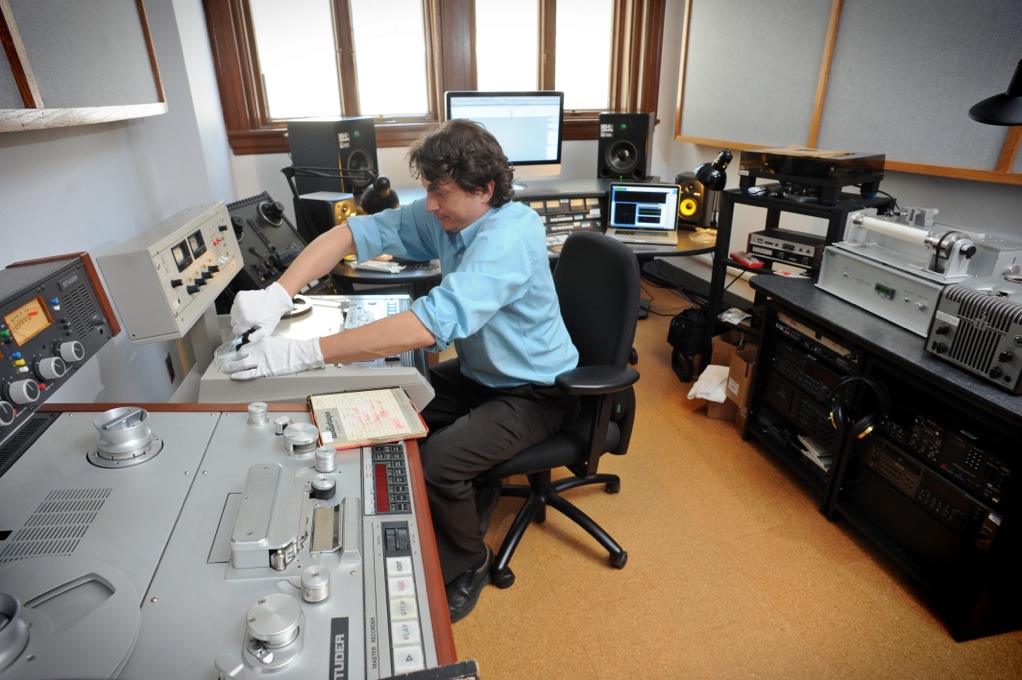 UNESCO, in cooperation with the Co-ordinating Council of Audiovisual Archives Associations (CCAAA) and other partners, has adopted 27 October as the World Day for Audiovisual Heritage to better focus global attention on the significance of AV documents and to draw attention to the need to safeguard them. The theme for this year’s celebration is “Saving Our Heritage for the Next Generation.”
UNESCO, in cooperation with the Co-ordinating Council of Audiovisual Archives Associations (CCAAA) and other partners, has adopted 27 October as the World Day for Audiovisual Heritage to better focus global attention on the significance of AV documents and to draw attention to the need to safeguard them. The theme for this year’s celebration is “Saving Our Heritage for the Next Generation.”
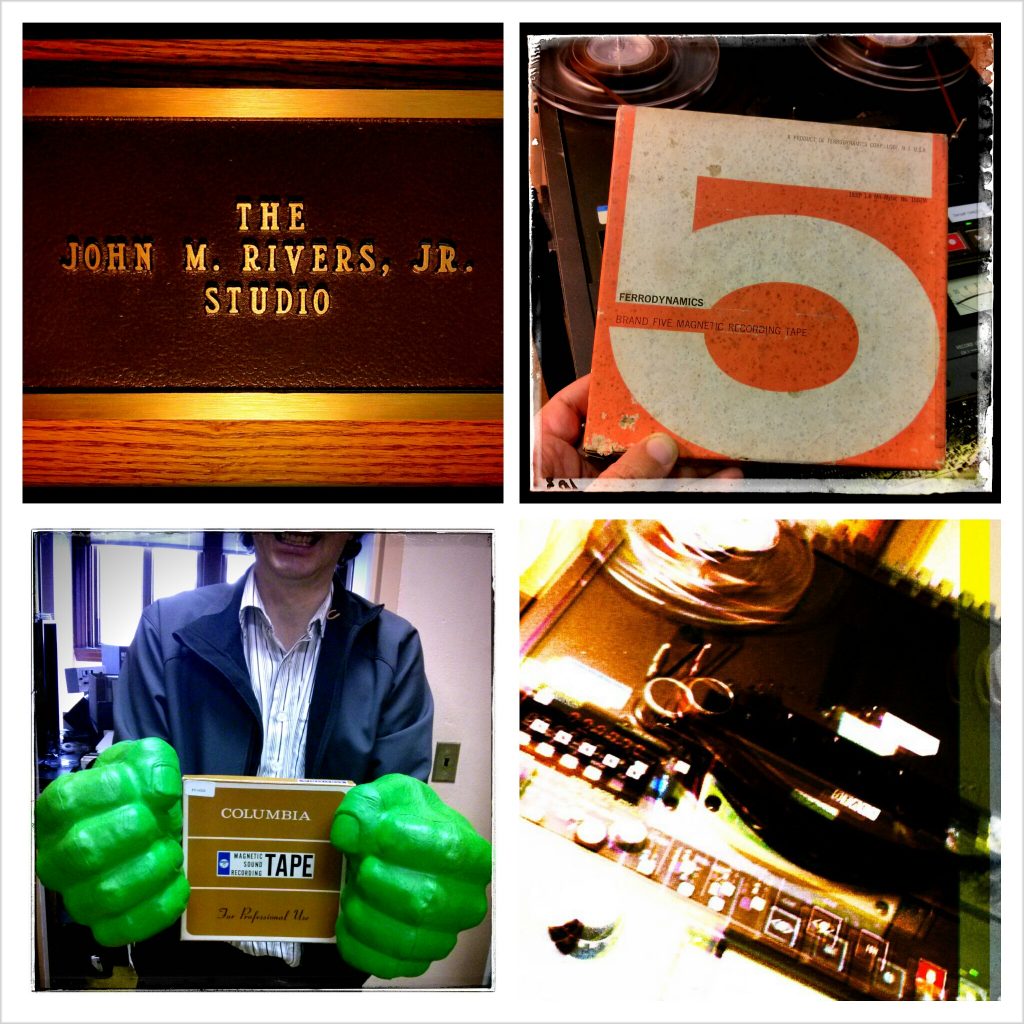 The Southern Folklife Collection works toward this goal daily in our efforts to preserve the hundreds of thousands of sound recordings, film and video housed in Wilson Library. Through grant-funded digitization projects and through research driven requests, the Southern Folklife Collection has digitized and made available tens of thousands of recordings documenting the vast riches of traditional expressive culture from the American South and around the world. The John M. Rivers, Jr. Studio (pictured above, right, and below) and the Ben Jones Audio and Video Studios constantly echo with the sounds, songs, and stories collected from centuries past through the 21st.
The Southern Folklife Collection works toward this goal daily in our efforts to preserve the hundreds of thousands of sound recordings, film and video housed in Wilson Library. Through grant-funded digitization projects and through research driven requests, the Southern Folklife Collection has digitized and made available tens of thousands of recordings documenting the vast riches of traditional expressive culture from the American South and around the world. The John M. Rivers, Jr. Studio (pictured above, right, and below) and the Ben Jones Audio and Video Studios constantly echo with the sounds, songs, and stories collected from centuries past through the 21st.
From the UNESCO statement:
Audiovisual documents, such as films, radio and television programmes, are our common heritage and contain the primary records of the 20th and 21st centuries. They help to maintain the cultural identity of a people; but countless documentary treasures have disappeared since the invention of image and sound technologies that permit the peoples of the world to better share their experiences, creativity and knowledge.
All of the world’s audiovisual heritage is endangered. Nowhere can it be said to be preserved, but through initiatives such as theWorld Day for Audiovisual Heritage and the Memory of the World Programme, the precious work of preservation professionals is given impetus to manage a range of technical, political, social, financial and other factors that threaten the safeguarding of our heritage.
It was in this context, that the General Conference in 2005 approved the commemoration of a World Day for Audiovisual Heritage as a mechanism to raise general awareness of the need for urgent measures to be taken and to acknowledge the importance of audiovisual documents as an integral part of national identity. (UNESCO)
In honor of the 7th World Day for Audiovisual Heritage, we wanted to highlight some of the recordings recently digitized as part of one of our current projects, From the Piedmont to the Swamplands: Preserving Southern Traditional Music, funded in part by the National Endowment for the Humanities. The multi-year effort will preserve and make accessible online up to 3,019 hours of sound recordings and 4,500 related photographs dating from the 1920s to 1980s, drawn from the Southern Folklife Collection holdings in the William R. Ferris Collection (20367), Mike Seeger Collection (20009), John Edwards Memorial Foundation Records (20001), and the Goldband Recording Corporation Collection (20245).
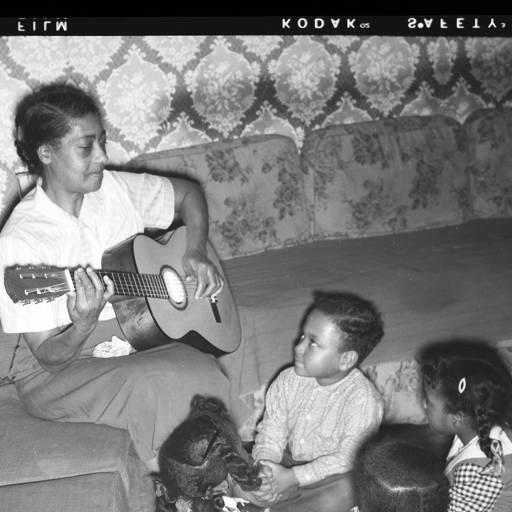 Regular readers of Field Trip South will not be surprised to see the Mike Seeger Collection featured here. Many of Seeger’s photographs are currently digitized and available for viewing online: iconic images of America’s musical treasures like Ralph and Carter Stanley, the Carter Sisters, Lesley Riddle, Dock Boggs, and of course, the beloved NC Piedmont picker and singer, Elizabeth Cotten.
Regular readers of Field Trip South will not be surprised to see the Mike Seeger Collection featured here. Many of Seeger’s photographs are currently digitized and available for viewing online: iconic images of America’s musical treasures like Ralph and Carter Stanley, the Carter Sisters, Lesley Riddle, Dock Boggs, and of course, the beloved NC Piedmont picker and singer, Elizabeth Cotten.
The Southern Folklife Collection has preserved hundreds of hours of Seeger’s field recordings and his own master tapes. Every tape is a treat, but occasionally we come upon an especially outstanding track like this version of “Well May the World Go” featuring Mike performing with his brother, the legendary folksinger Pete, on 29 January 1973. They tore through three versions of the tune that day. Have a listen to the third take of that piece here, from FT14925 in the Mike Seeger Collection:FT14295_Mike_Seeger_&_Pete_Seeger
Another recent standout track comes from The New Tranquility String Band (FT14198.) This outtake of “Boatman” was recorded during sessions for the Berkley Farms: Oldtime and Country Style Music of Berkley LP originally released for Smithsonian Folkways in 1972. This version version has the jaw harp higher in the mix, giving it a striking old-time feel that we like. FT14198_Mike_Seeger_Berkley
 The Piedmont to the Swamplands grant also allowed us to digitize the majority of audio recordings collected by folklorist and UNC professor William R. Ferris. With thousands of audio recordings, photographs, and feet of film, the William R. Ferris Collection is an invaluable resource documenting the people and culture of the American South, an archival treasure trove reflecting the ineffable “sense of place” that makes the South such a compelling–and haunting–place. Many of Ferris’s photographs are available online. This performance by a young child, Don Singleton recorded on FT 9918, made our jaws drop.
The Piedmont to the Swamplands grant also allowed us to digitize the majority of audio recordings collected by folklorist and UNC professor William R. Ferris. With thousands of audio recordings, photographs, and feet of film, the William R. Ferris Collection is an invaluable resource documenting the people and culture of the American South, an archival treasure trove reflecting the ineffable “sense of place” that makes the South such a compelling–and haunting–place. Many of Ferris’s photographs are available online. This performance by a young child, Don Singleton recorded on FT 9918, made our jaws drop.
FT9918_BFC_FANNIE BELL CHILDRENS CONCERT
This next tape was recorded during the process of filming a documentary film about the remarkable Fannie Bell Chapman. The complete film can be viewed in full on Folkstreams.net., Fannie Bell Chapman: Gospel Singer. The following version of “Now Sister Go Where I Send Thee” is from FT9974, the first of six tapes recording Chapman’s music recorded in August 1975. FT9974_BFC_Fannie Bell Chapman_Now Sister Go Where I Send Thee
 Ferris documented the secular as well as the sacred and his recordings of Mississippi blues artists are equally vital documents. The following track is from one of the first recordings of the bluesman “Big Jack” Johnson. From FT11151, this is Johnson performing on guitar with harmonica player Wash Herron. FT11151_BFC_Wash Herron_Big Jack_Johnson
Ferris documented the secular as well as the sacred and his recordings of Mississippi blues artists are equally vital documents. The following track is from one of the first recordings of the bluesman “Big Jack” Johnson. From FT11151, this is Johnson performing on guitar with harmonica player Wash Herron. FT11151_BFC_Wash Herron_Big Jack_Johnson
These clips offer but a glimpse into the Southern Folklife Collection’s preservation efforts. The public is encouraged to explore our finding aids for detailed inventories and description of archival collections and the UNC Libraries online catalog for materials of interest and request that they be preserved and made available for research. Feel free to contact the SFC with any comments or questions at wilsonlibrary@unc.edu. We also hope you will enjoy some music this Sunday, October 27, World Day for Audiovisual Heritage, and think about institutions like the Southern Folklife Collection, the Library of Congress, and countless other archives and institutions that are working to preserve our aural and visual history. 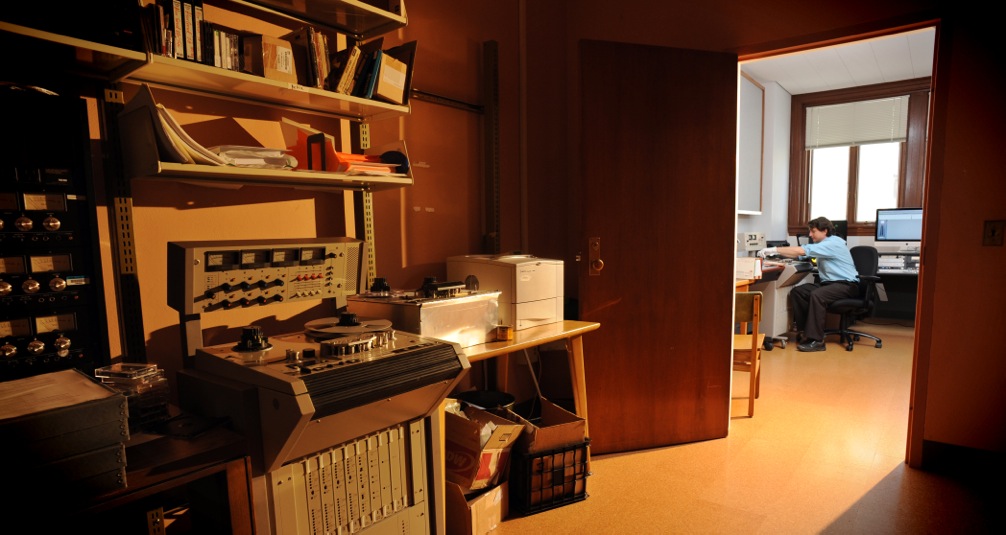
Master tape of the week: Chester Randle's Soul Sender's
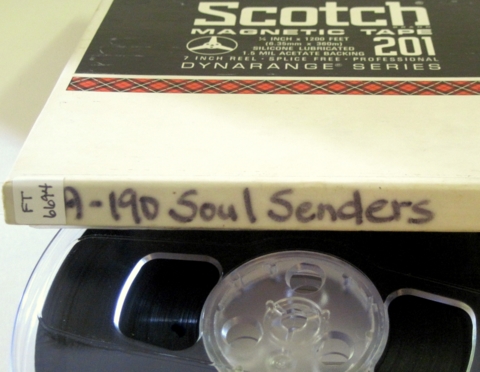 A recent patron inquiry about Chester Randle’s Soul Sender’s got us digging through the masters in the Goldband Recording Corporation Collection, 1930-1995 (#20245) to find this open reel tape of Soul Sender’s alternate takes and practice jams. These tracks are rough and the arrangements are only just coming together, but Randle’s heavily distorted guitar cuts through the mud-sludge bass while Milford Scott’s hammond B-3 organ practically pours over the raw funk of Bill Parker’s drumbeat. The full weight of Lake Charles’ humid swamp air lays heavy on this boogie. Sounds great to us.
A recent patron inquiry about Chester Randle’s Soul Sender’s got us digging through the masters in the Goldband Recording Corporation Collection, 1930-1995 (#20245) to find this open reel tape of Soul Sender’s alternate takes and practice jams. These tracks are rough and the arrangements are only just coming together, but Randle’s heavily distorted guitar cuts through the mud-sludge bass while Milford Scott’s hammond B-3 organ practically pours over the raw funk of Bill Parker’s drumbeat. The full weight of Lake Charles’ humid swamp air lays heavy on this boogie. Sounds great to us.
There are three different versions of each “Sweet Potato” and “Soul Brother’s Testify” on FT-6694. Unlike the final versions, these rehearsal tapes do not feature horns as part of the ensemble. It’s great to hear the band try on licks and solos, developing the lyrics and arrangements, and laying down some seriously noisy sounds. These tracks eventually saw release on Eddie Shuler’s ANLA imprint. “Soul Brother’s Testify, parts 1 and 2,” (ANLA 102) is a sought after release by funk and soul record collectors and the opening breakbeat has been heavily sampled by hip hop artists. For more information on ANLA releases in the collection see the Goldband finding aid, the SFC Goldband online exhibit, and the list below, but for now, some music.
– “Sweet Potato,” take 3, intro
FT_6694_Sweet Potato_1
– “Sweet Potato,” take 2, guitar solo
FT_6694_Sweet Potato_Solo
– “Soul Brother’s Testify,” take 3, intro
FT_6694_Soul Brother’s Testify_Intro
– “Soul Brother’s Testify,” take 3, end
FT_6694_Soul Brother’s Testify_End
The Soul Sender’s ensemble appears on recordings under a few different names with only slight variation–The Original Soul Sender’s, Charles Randle’s Soul Sender’s, sometimes without apostrophes. Guitarist Charles Randle performed with Bill Parker, Milford Scott, and likely the unknown musicians as well, in a variety of groups like Clarence Garlow & His Accordion and the Chester Randle Orchestra. Bill Parker was himself a local R&B star in the early 1960s with his Showboat Band, a group that also occasionally featured young guitarist Chester Randle. Parker recorded numerous other sides for ANLA and Goldband and eventually founded his own Showboat Records.
 Eddie Shuler started ANLA in the 1960s to feature soul and R&B artists from South Louisiana and East Texas as an extension of the blues, cajun, swamp pop, and zydeco music he released on his Goldband Record label. Shuler founded Goldband in the 1940s initially to release country, cajun, and western swing records, including those by his own band, the All Star Reveliers. In the early 1950s, Shuler bought an old holiness Church at 313 Church Street in north Lake Charles, Louisiana and developed the Goldband Complex, including a recording studio, record shop, and Shuler’s television repair business, Eddie’s Quick Service TV.
Eddie Shuler started ANLA in the 1960s to feature soul and R&B artists from South Louisiana and East Texas as an extension of the blues, cajun, swamp pop, and zydeco music he released on his Goldband Record label. Shuler founded Goldband in the 1940s initially to release country, cajun, and western swing records, including those by his own band, the All Star Reveliers. In the early 1950s, Shuler bought an old holiness Church at 313 Church Street in north Lake Charles, Louisiana and developed the Goldband Complex, including a recording studio, record shop, and Shuler’s television repair business, Eddie’s Quick Service TV.

Shuler recorded regional artists for a regional market, distributing the recordings from the back of his car to record stores and to jukebox operators who placed the records on jukeboxes leased to local clubs, dancehalls, and restaurants. Shuler had an ear for talent and for the changing tastes of his audience, building an impressive roster of artists over the years, including the first recordings of legendary Cajun accordionist Iry LeJune, the first hit record by then 13 year old Dolly Parton, Rockin’ Sidney, Boozoo Chavis, Cookie and the Cupcakes, and Cleveland Crochet, whose 1961 recording “Sugar Bee” became the first Cajun tune to break the Billboard Top 100. Shuler’s accomplishments and struggles in the music industry are too many to list here, but for one of the best written histories the music of South Louisiana, see John Broven’s 1983 book South to Louisiana: the music of the Cajun bayous.
audience, building an impressive roster of artists over the years, including the first recordings of legendary Cajun accordionist Iry LeJune, the first hit record by then 13 year old Dolly Parton, Rockin’ Sidney, Boozoo Chavis, Cookie and the Cupcakes, and Cleveland Crochet, whose 1961 recording “Sugar Bee” became the first Cajun tune to break the Billboard Top 100. Shuler’s accomplishments and struggles in the music industry are too many to list here, but for one of the best written histories the music of South Louisiana, see John Broven’s 1983 book South to Louisiana: the music of the Cajun bayous.
Original/Chester Randle’s Soul Senders materials in the Southern Folklife Collection include both 45 rpm records and open reel tape. Follow the following link for more information on the materials listed below, Goldband Recording Corporation Collection, 1930-1995 (#20245):
45-8083, ANLA AL-102, “Soul Brother’s Testify”/”Soul Brother’s Testify”
45-8085 ANLA AL-118. “Low Blow, Part I”/”Low Blow, Part II”
45-8088 ANLA AN-105. “Take a Little Nip”/”Why did I let you go,”
Open reels: FT-6694; FT-6695; FT-7031; FT-7758; FT-7774; FT-7861; FT-7896; FT-7933; and FT-7968.
Photo of the Week: Jo-El Sonnier
 Jo-El Sonnier of Rayne, Louisiana, photographed ca. 1968. Two decades later “The Cajun Valentino” would score a top-ten country hit with a cover of Richard Thompson’s “Tear Stained Letter”. Photo from the Goldband Records Collection.
Jo-El Sonnier of Rayne, Louisiana, photographed ca. 1968. Two decades later “The Cajun Valentino” would score a top-ten country hit with a cover of Richard Thompson’s “Tear Stained Letter”. Photo from the Goldband Records Collection.
Iry LeJeune Recordings Added to National Recording Registry
 The Library of Congress has named two recordings by Cajun accordionist and singer Iry LeJeune to the National Recording Registry. “Evangeline Special” and “Love Bridge Waltz” were both recorded for Goldband Records in 1948 and the original master tapes are housed in the SFC’s Goldband Records Collection.
The Library of Congress has named two recordings by Cajun accordionist and singer Iry LeJeune to the National Recording Registry. “Evangeline Special” and “Love Bridge Waltz” were both recorded for Goldband Records in 1948 and the original master tapes are housed in the SFC’s Goldband Records Collection.
From the Library of Congress press release:
“The post-World War II revival of traditional Cajun music began with accordionist Iry LeJeune’s first single, his influential recordings of “Evangeline Special” and “Love Bridge Waltz.” Le Jeune’s emotional and deeply personal style was immensely popular with Louisiana Cajuns returning home from the war, eager to hear their own music again. His recordings marked a distinct move away from the style influenced by Western Swing that had dominated commercial Cajun recordings for over a decade and a return to the older sound of Cajun music. This sound featured the accordion, prominently and unrestrained, and a blues-influenced singing in French. LeJeune is regarded as one of the best Cajun accordionists and singers of all time.”
Listen below to clips of both songs:
Evangeline Special clip
Love Bridge Waltz clip
Clips from SFC CD-713, The Legendary Iry Lejeune.
Photo of the Week: Count Rockin' Sidney
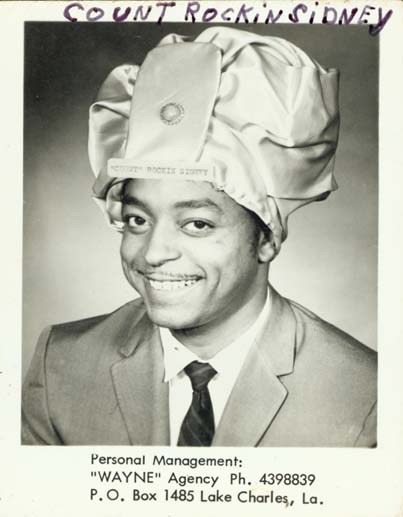 Louisiana R&B singer Count Rockin’ Sidney in a ca. 1965 promotional photo from the Goldband Records Collection.
Louisiana R&B singer Count Rockin’ Sidney in a ca. 1965 promotional photo from the Goldband Records Collection.

